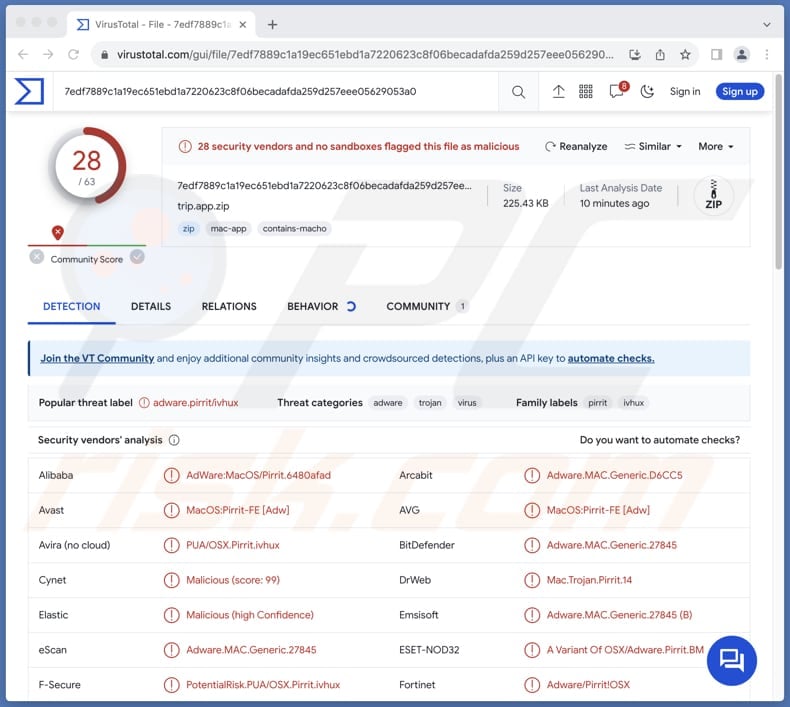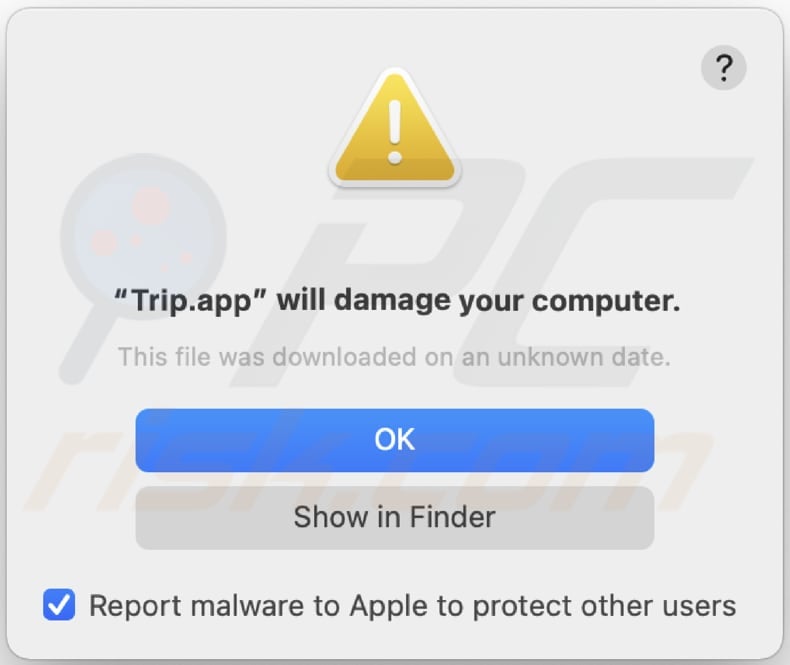Get free scan and check if your device is infected.
Remove it nowTo use full-featured product, you have to purchase a license for Combo Cleaner. Seven days free trial available. Combo Cleaner is owned and operated by RCS LT, the parent company of PCRisk.com.
What kind of application is Trip.app?
Following scrutiny, the established conclusion is that Trip.app is an advertising-supported application, given its capacity to display intrusive ads. This app is part of the Pirrit family. Typically, users download apps like Trip.app from unreliable sources, exposing themselves to potential risks associated with such downloads.

Trip.app adware in detail
Ads (e.g., pop-ups and banners) displayed by Trip.app, as is common with ad-supported apps, can lead users to unreliable pages that pose potential risks to their online security and privacy. Some ads may redirect users to phishing websites designed to deceive them into revealing sensitive information such as login credentials, personal details, or financial information.
Also, ads from the Trip.app might prompt users to download software or apps from unverified sources, leading to the installation of potentially harmful or malicious content on their devices. This could result in security vulnerabilities, data breaches, or unwanted access to personal information.
Furthermore, Users may encounter ads that lead to scam pages, attempting to defraud individuals through various schemes. These scams could involve fake contests, surveys, or offers that aim to exploit users financially or extract personal information.
An additional concern associated with Trip.app pertains to the potential gathering of various data. Applications like Trip.app frequently collect user information, including browsing habits and preferences, in order to present more tailored advertisements. Sometimes, the obtained data can be misused for malicious purposes.
| Name | Ads by Trip.app |
| Threat Type | Adware, Mac malware, Mac virus |
| Detection Names | Avast (MacOS:Pirrit-FE [Adw]), Combo Cleaner (Adware.MAC.Generic.27845), ESET-NOD32 (A Variant Of OSX/Adware.Pirrit.BM), Kaspersky (Not-a-virus:HEUR:AdWare.OSX.Pirrit.ac), Full List (VirusTotal) |
| Symptoms | Your Mac becomes slower than normal, you see unwanted pop-up ads, you are redirected to dubious websites. |
| Distribution methods | Deceptive pop-up ads, free software installers (bundling), torrent file downloads. |
| Damage | Internet browser tracking (potential privacy issues), display of unwanted ads, redirects to dubious websites, loss of private information. |
| Malware Removal (Windows) |
To eliminate possible malware infections, scan your computer with legitimate antivirus software. Our security researchers recommend using Combo Cleaner. Download Combo CleanerTo use full-featured product, you have to purchase a license for Combo Cleaner. 7 days free trial available. Combo Cleaner is owned and operated by RCS LT, the parent company of PCRisk.com. |
Conclusion
In conclusion, Trip.app is identified as adware, manifesting through the display of intrusive advertisements and posing potential risks to user data. In order to minimize these vulnerabilities, it is strongly recommended that users approach Trip.app with caution, promptly uninstall the application, and implement dependable security measures to protect their systems from adware-related threats.
Examples of similar apps are ActiveChannel, GuideLibrary, and Reinquire.
How did Trip.app install on my computer?
Users often unknowingly consent to adware installation when they swiftly proceed through free software installation processes without meticulously reviewing the terms and conditions and changing the provided settings (e.g., "Advanced," "Custom," or "Manual").
Another prevalent approach employed by adware involves deceptive ads, pop-ups, and fraudulent software updates. Obtaining downloads from peer-to-peer (P2P) networks, dubious websites, third-party app stores, and similar sources can also lead to the accidental installation of adware on systems.
How to avoid installation of unwanted applications?
Download software exclusively from official websites or trusted app stores. Be vigilant during installation processes and deselect any checkboxes or change settings indicating additional software installations. Keep all software, including security programs and browsers, regularly updated to safeguard against known vulnerabilities.
Install and consistently update reliable antivirus and anti-malware software to identify and eliminate adware. Refrain from clicking on ads, pop-ups, and similar content on suspicious or untrustworthy websites. If your computer is already infected with Trip.app, we recommend running a scan with Combo Cleaner Antivirus for Windows to automatically eliminate this adware.
When removing Trip, it is important to check these folders for its components (the filenames may differ in each folder, yet every single one should contain "trip"):
- ~/Library/LaunchAgents
- /Library/LaunchDaemons
- /Library/LaunchAgents
- /Library/StartupItems
The warning that appears before installing Trip.app:

Text in this warning:
"Trip.app" will damage your computer.
This file was downloaded on an unknown date.
Instant automatic malware removal:
Manual threat removal might be a lengthy and complicated process that requires advanced IT skills. Combo Cleaner is a professional automatic malware removal tool that is recommended to get rid of malware. Download it by clicking the button below:
DOWNLOAD Combo CleanerBy downloading any software listed on this website you agree to our Privacy Policy and Terms of Use. To use full-featured product, you have to purchase a license for Combo Cleaner. 7 days free trial available. Combo Cleaner is owned and operated by RCS LT, the parent company of PCRisk.com.
Quick menu:
- What is Trip.app?
- STEP 1. Remove Trip.app related files and folders from OSX.
- STEP 2. Remove Trip.app ads from Safari.
- STEP 3. Remove Trip.app adware from Google Chrome.
- STEP 4. Remove Trip.app ads from Mozilla Firefox.
Video showing how to remove adware and browser hijackers from a Mac computer:
Trip.app adware removal:
Remove Trip.app-related potentially unwanted applications from your "Applications" folder:

Click the Finder icon. In the Finder window, select "Applications". In the applications folder, look for "MPlayerX", "NicePlayer", or other suspicious applications and drag them to the Trash. After removing the potentially unwanted application(s) that cause online ads, scan your Mac for any remaining unwanted components.
DOWNLOAD remover for malware infections
Combo Cleaner checks if your computer is infected with malware. To use full-featured product, you have to purchase a license for Combo Cleaner. 7 days free trial available. Combo Cleaner is owned and operated by RCS LT, the parent company of PCRisk.com.
Remove adware-related files and folders

Click the Finder icon, from the menu bar. Choose Go, and click Go to Folder...
 Check for adware generated files in the /Library/LaunchAgents/ folder:
Check for adware generated files in the /Library/LaunchAgents/ folder:

In the Go to Folder... bar, type: /Library/LaunchAgents/

In the "LaunchAgents" folder, look for any recently-added suspicious files and move them to the Trash. Examples of files generated by adware - "installmac.AppRemoval.plist", "myppes.download.plist", "mykotlerino.ltvbit.plist", "kuklorest.update.plist", etc. Adware commonly installs several files with the exact same string.
 Check for adware generated files in the ~/Library/Application Support/ folder:
Check for adware generated files in the ~/Library/Application Support/ folder:

In the Go to Folder... bar, type: ~/Library/Application Support/

In the "Application Support" folder, look for any recently-added suspicious folders. For example, "MplayerX" or "NicePlayer", and move these folders to the Trash.
 Check for adware generated files in the ~/Library/LaunchAgents/ folder:
Check for adware generated files in the ~/Library/LaunchAgents/ folder:

In the Go to Folder... bar, type: ~/Library/LaunchAgents/

In the "LaunchAgents" folder, look for any recently-added suspicious files and move them to the Trash. Examples of files generated by adware - "installmac.AppRemoval.plist", "myppes.download.plist", "mykotlerino.ltvbit.plist", "kuklorest.update.plist", etc. Adware commonly installs several files with the exact same string.
 Check for adware generated files in the /Library/LaunchDaemons/ folder:
Check for adware generated files in the /Library/LaunchDaemons/ folder:

In the "Go to Folder..." bar, type: /Library/LaunchDaemons/

In the "LaunchDaemons" folder, look for recently-added suspicious files. For example "com.aoudad.net-preferences.plist", "com.myppes.net-preferences.plist", "com.kuklorest.net-preferences.plist", "com.avickUpd.plist", etc., and move them to the Trash.
 Scan your Mac with Combo Cleaner:
Scan your Mac with Combo Cleaner:
If you have followed all the steps correctly, your Mac should be clean of infections. To ensure your system is not infected, run a scan with Combo Cleaner Antivirus. Download it HERE. After downloading the file, double click combocleaner.dmg installer. In the opened window, drag and drop the Combo Cleaner icon on top of the Applications icon. Now open your launchpad and click on the Combo Cleaner icon. Wait until Combo Cleaner updates its virus definition database and click the "Start Combo Scan" button.

Combo Cleaner will scan your Mac for malware infections. If the antivirus scan displays "no threats found" - this means that you can continue with the removal guide; otherwise, it's recommended to remove any found infections before continuing.

After removing files and folders generated by the adware, continue to remove rogue extensions from your Internet browsers.
Remove malicious extensions from Internet browsers
 Remove malicious Safari extensions:
Remove malicious Safari extensions:

Open the Safari browser, from the menu bar, select "Safari" and click "Preferences...".

In the preferences window, select "Extensions" and look for any recently-installed suspicious extensions. When located, click the "Uninstall" button next to it/them. Note that you can safely uninstall all extensions from your Safari browser - none are crucial for regular browser operation.
- If you continue to have problems with browser redirects and unwanted advertisements - Reset Safari.
 Remove malicious extensions from Google Chrome:
Remove malicious extensions from Google Chrome:

Click the Chrome menu icon ![]() (at the top right corner of Google Chrome), select "More Tools" and click "Extensions". Locate all recently-installed suspicious extensions, select these entries and click "Remove".
(at the top right corner of Google Chrome), select "More Tools" and click "Extensions". Locate all recently-installed suspicious extensions, select these entries and click "Remove".

- If you continue to have problems with browser redirects and unwanted advertisements - Reset Google Chrome.
 Remove malicious extensions from Mozilla Firefox:
Remove malicious extensions from Mozilla Firefox:

Click the Firefox menu ![]() (at the top right corner of the main window) and select "Add-ons and themes". Click "Extensions", in the opened window locate all recently-installed suspicious extensions, click on the three dots and then click "Remove".
(at the top right corner of the main window) and select "Add-ons and themes". Click "Extensions", in the opened window locate all recently-installed suspicious extensions, click on the three dots and then click "Remove".

- If you continue to have problems with browser redirects and unwanted advertisements - Reset Mozilla Firefox.
Frequently Asked Questions (FAQ)
What harm can adware cause?
Adware can cause several issues for users, including intrusive and disruptive advertisements, compromised system performance, potential privacy breaches through data collection, and an increased risk of exposure to other types of malware.
What does adware do?
Adware primarily displays unwanted advertisements to users, often in a disruptive and intrusive manner. It may also collect user data and hijack browsers.
How do adware developers generate revenue?
Adware developers commonly make money by promoting products, websites, or services, and a substantial portion of their earnings comes from engaging in affiliate programs.
Will Combo Cleaner remove Trip.app adware?
Combo Cleaner effectively scans computers and removes adware-type applications. Manual removal without security programs may be ineffective, as residual files can remain hidden even after the adware is deleted, potentially causing ongoing issues. Thorough removal is essential.
Share:

Tomas Meskauskas
Expert security researcher, professional malware analyst
I am passionate about computer security and technology. I have an experience of over 10 years working in various companies related to computer technical issue solving and Internet security. I have been working as an author and editor for pcrisk.com since 2010. Follow me on Twitter and LinkedIn to stay informed about the latest online security threats.
PCrisk security portal is brought by a company RCS LT.
Joined forces of security researchers help educate computer users about the latest online security threats. More information about the company RCS LT.
Our malware removal guides are free. However, if you want to support us you can send us a donation.
DonatePCrisk security portal is brought by a company RCS LT.
Joined forces of security researchers help educate computer users about the latest online security threats. More information about the company RCS LT.
Our malware removal guides are free. However, if you want to support us you can send us a donation.
Donate
▼ Show Discussion